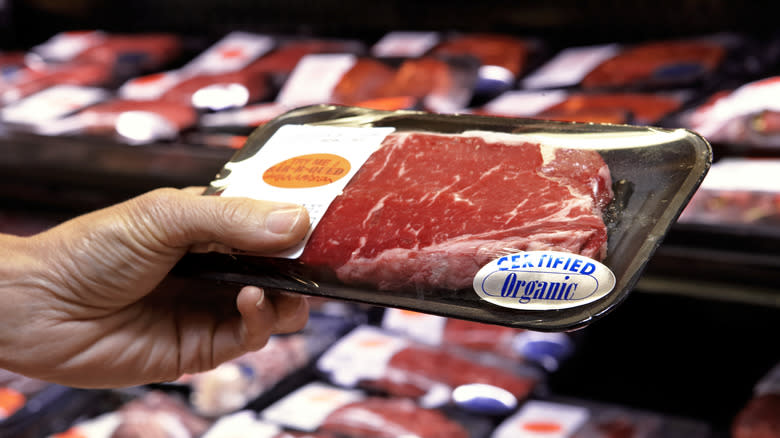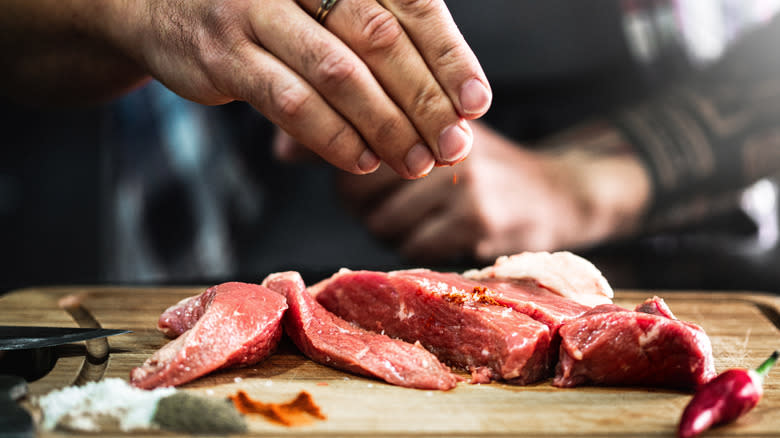Don't Be Concerned If Your Costco Beef Has A Blue Mark On It

When it comes to buying meat, shoppers are hypervigilant for anything that looks a bit off. Since spoiled meat can cause foodborne illnesses, it's best to pay attention to any strange colors in your meat. However, if you notice your steak at Costco has a bit of blue in it, then you probably shouldn't be concerned. It just means that your meat has been properly inspected.
The USDA inspects all commercial meat sold for human consumption, and inspectors mark the meat with a stamp to show that they have approved it to be distributed. But for customers who don't know about the stamp, it can be a bit alarming to see on one's meat. One surprised Redditor shared a picture of beef they purchased at Costco, writing, "What is the blue color on the fat of the steak I just bought at Costco?" The post got a number of amusing responses, with one person writing, "That's a blueberry steak!"
As for the actual ink, it's harmless to ingest. According to the USDA, the ink can be made with a number of additives including corn syrup, isopropyl alcohol, and acetone. However, it's generally safe to eat, so you don't have anything to worry about. In fact, it's a good thing that it may have the mark.
Read more: All The Benefits Of A Costco Membership
Why Meat Is Inspected

If you've never seen the blue mark on your meat before, then it's likely due to a combination of factors. The blue inspection marker is more for butchers and meat packers than it is for general consumers. It indicates to the butcher that the meat has been inspected, and it's of good quality to be sold.
All cattle in the United States are inspected by the Food Safety and Inspection Service (FSIS) prior to the animal carcasses being distributed for consumption. One of the responsibilities of the FSIS is to investigate the conditions of the animals and if they are being slaughtered humanely. Likewise, these inspectors are also trained to examine the meat and identify any potential worrisome signs for disease or contamination. This is particularly important since these animal carcasses are distributed to butchers nationwide.
If any animal carcasses show signs of disease, then they are separated from the rest of the supply and further examined. For this reason, the blue mark is a good thing, as it's a sign to butchers that the meat has been approved by the organization. However, there's a reason you may not normally see the blue mark.
Why You May Not Have Noticed The Mark

Typically, inspectors will mark a portion of the animal that's unlikely to be sold. However, that's not always the case. Sometimes, this mark may show up on meat that ends up in a store like Costco. In particular, your bacon may sometimes have a bit of blue in it. Sausage is also a likely place to find remnants of the mark since the meat is usually ground up. For this same reason, you may find it in hamburger meat. So it's a bit like playing the lottery or flipping a coin, you never know which cut of meat will bear the inspection mark, but if yours does, there's nothing to worry about.
While butchers, especially those at a local shop, like to use every part of the animal, typically they will try to remove the blue inspection marker. As one person on Reddit observed, "Good butchers would trim that off and make sure it looks nice."
While a little bit of blue in your meat is no reason to toss it in the bin, it is also extremely important to pay attention to the colors of your meat. The color of your meat can convey how fresh it is and whether it has spoiled or not.
Read the original article on Daily Meal.

